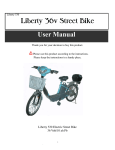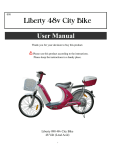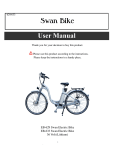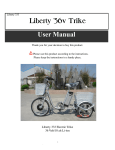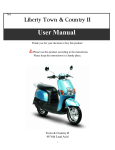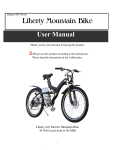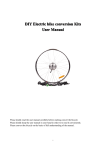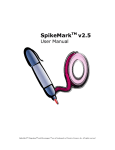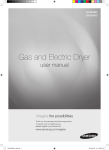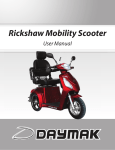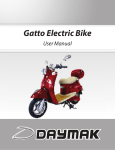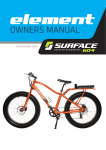Download 817 Manual - Liberty Electric Bikes
Transcript
Liberty 817 48 Volt Liberty 48v Street Bike User Manual Thank you for your decision to buy this product. Please use this product according to the instructions. Please keep the instructions in a handy place. Liberty 817 Electric Bike 48 Volt/10 ah Lead Acid . 1 Introduction Dear Customer, Wow! You are excited! You have just received your brand new ebike. We, too, are excited because as designers and developers of our bikes, we love to make you happy, and we believe your new ebike will give you lots of fun. I know you want to get this bike on the road immediately, but please STOP! Why? Well, first of all, you need to charge your batteries fully before using them. So, while your ebike is charging, take the time to read this manual. We have worked hard to make it as readable as possible. This manual will help prevent injury and teach you how to care for your new ebike. It is the owner’s responsibility to carefully read all of the contents of this manual and to comply with all laws pertaining to the operation of bicycles and/or electric bicycles in your local jurisdiction. If you have any questions, please consult with the laws web page on www.iloveEbikes.com or consult your local department of motor vehicles for clarification. These electric bikes are not classified as motor vehicles, however, to drive them on the roads various states have differing laws. We have worked hard to provide you a quality, well-designed product without defects. That is our responsibility. You, too, have a part to play. With proper care, maintenance and attention to bicycle safety rules, your ebike will give you years of enjoyment. Please read the instructions carefully before using your ebike. Do not ride this bicycle until you have read and thoroughly understand the owner’s manual. It contains information critical to your safety. If you have questions about the operation of this electric bicycle, consult your authorized dealer. It is extremely important that you follow the safety guidelines contained in this manual in order to ensure your maximum safety. If you loan your bike to anyone, make sure they also know how to operate it safely. When using, the load should not be greater than the maximum capacity, and please pay attention to increase the braking distance during rainy or snowy days. This ebike can operate in the rain and snow, but it CANNOT be submerged in water. When the motor is submerged in water, it may short circuit and fail, which is NOT covered by the warranty. Please don't dismantle and repair the spare parts by yourself, but go to the local dealer. Please take time to record the following information: Recording Your Ebike Info Serial Number: _______________________________________________________ Model: _________________________ 817___________________________ Color: _______________________________________________________ Date of Purchase: _______________________________________________________ Dealer’s Name: _______________________________________________________ Dealer’s Ph. #: _______________________________________________________ Dealer’s Email: _______________________________________________________ . 2 The serial number is located on the right side of the front steering tube. Important Instructions Safeguard your battery to insure continued high performance. It should be recharged after each use. The normal full-cycle battery life, if it is continuously discharged and recharged, is between 300–1000 cycles (depending on which battery came with your bike) after which the storage capacity of the battery will gradually decline. CAUTION! Fully charge the batteries before the first use! Failure to do this can result in decreased battery performance for the life of the bike. Fully charge the battery each time you use the bike. Battery performance is affected by the temperature and is generally better in warm temperatures. When the temperature is below 32º F (0º C), the battery current may decrease by a third. Consequently, the travel range on a full charge in cold environments is much less, but will return to normal when the temperature is back to room temperature. Frequent stopping and starting, riding uphill, traveling against a strong wind, starting from a standstill, riding on rough or muddy roads, and carrying more than one person or heavy loads will consume extra battery power and shorten the range. A few tips to prolong the battery life during these conditions is as follows: Frequent braking – try to look ahead and coast rather than frequently stopping and starting. Riding uphill or against a stiff wind – pedal to supplement the battery power. When starting from a standstill, use the pedals to help bring you up to speed. When the battery meter indicates the voltage is low, switch to manual power and avoid using the battery, so you don’t shorten the battery life. To prevent premature failure of your battery and for your warranty to remain in effect on your battery, YOU MUST CHARGE AND DISCHARGE THE BATTERY AT LEAST ONCE PER MONTH. Always turn off the motor and remove the key from the ignition before and during charging to prevent serious damage to the controller and to the batteries! This electric bicycle can be used in the rain, however, the motor and other electrical parts must not be submerged in water. The controller, motor and other electrical devices may be short circuited causing damage, which is NOT covered by warranty, and creating possible dangerous situations. DO NOT use chargers or other components other than that which has been approved and tested by this company. This company is not responsible for damages caused by the use of other products not specifically designed and tested for use with this electric bike. Battery chargers contain sensitive electronics. Improper use, dropping, or sudden jolts can damage the charger and its internal electronics which is NOT covered by warranty. Do not leave the charger on for more than 10 hours! Check all nuts, bolts, screws, and spokes to make sure they are tight before riding. If any screws, nuts, or bolts are loose, put some thread lock on the threads and then tighten. When riding down hill, you MUST have the key on even if you are NOT using the throttle and even if the battery is not in the bike. The motor will generate enough electricity to RUIN your controller which is NOT covered by warranty. . 3 Table of Contents Introduction ...............................................................................................................2 Important Instructions ...............................................................................................3 Table of Contents ......................................................................................................4 Safety Precautions .....................................................................................................5 Assembly ..................................................................................................................6 General Operating Instructions .................................................................................8 Battery Precautions ...................................................................................................9 Maintenance .............................................................................................................10 Troubleshooting........................................................................................................11 Warranty ...................................................................................................................12 Federal Electric Bike Law .......................................................................................13 . 4 Safety Precautions • Before operating your bicycle, inspect it carefully to avoid accidents or damage. • Do not drive close to other vehicles. • ALWAYS keep the power switched OFF until you are seated on the bike and ready to ride. Turning the power on and then accidentally twisting the throttle can result in the bike lurching forward and may cause an accident, damage, or injury. • NEVER attempt to disassemble the motor, battery, controller or throttle. This can result in injury, fire, or damage to the bike. • ONLY use the charger supplied with your bike to charge the battery. Using the improper charger can result in fire or explosion. • KEEP the batteries out of the reach of children. • Obey all traffic laws relevant to the operation of bicycles and electric bicycles. • Use the turn signals (if equipped) or hand signals at all times when making turns. • KEEP both hands on the handlebars at all times. • DO NOT hang objects on or under the handlebars. • DO NOT brake suddenly in the rain or on slippery, wet surfaces. • USE extreme caution when riding near other vehicles. Assume they do not see you, and be careful at intersections and when starting from a stopped position. • When cleaning your electric bike, do not use a steady direct stream of water from a hose. Use a cloth to avoid short-circuiting any electrical components. Your electric bike has a durable finish and does not need to be waxed. Clean with a mild detergent and buff to restore its original shine. • Please wear a safety helmet and glasses for your own protection whenever riding. • Wear bright clothing to help make you visible to other motor vehicles. • Do not wear loose clothing that can become caught on the bicycle. • Do not leave the charger connected to the battery for more than 10 hours. . 5 ASSEMBLY Your new ebike will arrive partially assembled. We do this for ease and safety of shipping. If it ships on a skid, the batteries are installed. If it ships in two boxes, the batteries are not installed. Both methods of shipping will need the front wheel, the front basket, the pedals, and (optional) the rear trunk installed. Assembling of the Front Tire •Put the front brake into the center of the front wheel, taking note of the notch in the front brake housing. Slide the wheel into the front fork aligning the notch with the round peg on the front fork. •Adjust the front brakes by turning the adjustment bolt to tighten the brake cable. (See the picture on the left side for where to adjust.) Make sure the brake does not drag when brake is not engaged, but grabs tightly when the hand Notch brake is squeezed. Adjust Straightening Handlebars The handlebars of your bike are partially disassembled to ship. Loosen screws that hold the plastic protector and take off the bolts of the clamp. Put the handlebars in the clamp area, adjust to comfort level, and fasten with the clamp. Screw the plastic cover over the clamp (as shown in picture on right). If the handlebars are not aligned correctly you need to adjust them. To straighten them, place both legs on either side of the front tire. Holding the front tire between your legs, turn the handlebars until they are straight. They should turn fairly hard. If it is impossible to turn them, you can loosen the handlebar stem nut, turn the handlebars, and then tighten it again. Installing the Pedals •Note the left and right of the pedal. [ L ] left [ R ] right are stamped on the threaded end of the pedal. •Attach the L pedal to the L crank, then R pedal to R crank. •Screw the pedals in and tighten them fully. The L pedal has left-hand threads, and the R pedal has right-hand threads. Misapplication is not covered under warranty. Installing the Front Basket The front basket comes with parts for bracket to attach the front basket. Bolt the basket to the front mounting bracket that comes off the front of the bike (as shown in picture) through the white bracket. When you tighten these bolts, we recommend you use some thread-locking material such as LockTite to insure that road vibration does not vibrate your bolts loose. 6 . The bottom bracket is fastened to the white round bracket beneath the basket with the bracket and bolts provided as shown in picture. Installing Seat Your bike may come with the seat removed for protection in shipping. If this is true for your bike, then please note the picture on the right. Slide the seat stem into the seat clamp and adjust for proper height and tighten the clamp both as shown on the right. Battery The battery for your bike rests behind the seat post. It has a clamp on the battery plug-in to keep the cord from vibrating loose during riding. It is also where you connect the charger. To remove your bike power cord, flip the clamp so it releases the plug and unplug. Insert the charger cord into the battery plug-in before plugging in your power to your charger. To remove your battery, take your key and insert it into the lock on the left side of the battery just below the left rear suspension spring. Turn the key so that the locking pin releases the battery to be removed. Use the handle to lift the battery from its home position. Once out of the bike, use one hand under the battery case as it is heavy, and you don’t want to risk dropping it. You may choose to charge your battery while still in your bike. You do not have to remove it to charge it, but you may remove it if it is more convenient. Rear Brake Brake Adjustment The rear brake is a band brake. It is adjusted on the left side of the bike with a small wrench. The cable can also be adjusted at the handlebar brake lever by turning the small nut on the cable collar. The rear brake was adjusted at the factory, but from time to time you will need to adjust the brake. At the rear of the brake housing is a plastic cap that covers a round hole. This is to lock the rear hub for security. It will lock the rear brake so someone cannot ride your bike when you have it locked. Front Brake The front brake is a drum brake. It has a cable for adjustment by a nut at the brake, and the cable can also be adjusted at the handlebar brake lever by turning the small nut on the cable collar. Brake Adjustment . 7 General Operating Instructions BEFORE YOU RIDE 1. Charge your battery until the green indicator light on the charger comes on, but do not allow it to charge more than 10 hours. 2. Check the air pressure of the tires. Make sure they are at the recommended psi embossed on the sidewall of the tire. 3. Check the front and back brakes, and the condition of the front and back wheels, handlebar, and saddle. Make sure they are tight and fastened. Make sure all quick releases are locked and secure and that all parts are in good working order. Inspect your bike completely. 4. If it was removed, install the charged battery in the battery seat of bike and lock it. 5. Raise the kickstand. 6. Sit on the bike and turn the bike on. The power lights/meter should show your battery capacity. 7. Pedaling or using the throttle on the right hand will begin to accelerate the bike. ATTENTION: After the power is on, if the rider twists the throttle the bike will lurch forward! Do not turn the power on until you are ready to go. The hand brake will automatically cut the power to the motor as also will releasing the throttle. While starting or climbing a hill, pedal as much as possible, so that the electric power will not be drained too much. At the same time, it can lengthen the life of the battery and motor. ATTENTION: When riding down hills, do not turn off the power, otherwise the controller and motor will be easily damaged which is NOT covered under warranty. While running, if the battery power is getting low, the battery meter will lessen. At this time you should pedal your ebike like a regular bike and charge the battery as soon as you get to an electrical outlet. Turn off the power and remove the key while parking. If you decide to push your bike for any reason, make sure to turn the power off, so you don’t accidentally turn the throttle making the electric bicycle start suddenly and cause an accident. To help get the best distance out of your electric bike, refrain from a lot of braking and coast as much as possible. . 8 Battery Precautions •Do not touch the two poles of the battery with your hands when the battery is removed for charging. Also, the two battery poles should not be touched with any metal or other material that conducts electricity. •While charging, put the battery in a secure place where children can't reach. •Do not use any charger other than the one that came with your Liberty Electric Bike. If you need another charger, contact your local dealer. •Do not attempt to open or repair your charger. The electronics contain high-pressure circuits, so don’t dismantle by yourself. •Prevent liquids, metal and metal filings from permeating the charger, and be careful to not drop or hit the charger which could cause damage. •Do not put anything on top of the charger while charging. It must be well-ventilated to allow all the heat generated to dissipate. •When charging, if there is a peculiar smell or the temperature is too high, please stop charging immediately. •To prevent premature failure of your battery and for your warranty to remain in effect on your battery, YOU MUST CHARGE AND DISCHARGE THE BATTERY AT LEAST ONCE PER MONTH. Do NOT use in the battery in a very low state. •The charger will produce heat up to 185°F (85°C) in the course of using, so keep it away from flammable articles while using. •It is normal that the mileage capacity will reduce as a result of low temperatures. •While carrying the charger, DO NOT bump, drop, or damage, otherwise it may result in failure. •Avoid any contact with water when charging your battery. If a plug or socket gets wet, dry it completely before using. •Do not leave the charger connected to the battery and the outlet for more than 10 hours. •Always use the charger according to the instructions. . 9 MAINTENANCE Wheels: Wheels should be properly placed in the fork or dropouts. If you hear any irregular noise from the wheels or brakes, they should be checked and adjusted. The wheels should rotate smoothly without wobbling from side to side. Check the bearing play of the hubs regularly by lifting the bicycle and spinning the wheel. It should continue to spin for several turns after you stop spinning the wheel. The motorized wheel will NOT spin as freely as the non-motorized wheel. To check the play of the hubs, try to move the rim from side to side between the forks. No substantial play should exist. If you detect play or if the wheel is difficult to turn, please contact your local dealer or your local bike shop to have it serviced. Rims: The rims should be smooth and without cracks, breaks or bulges. Spokes: If your bike has spokes, check their tension regularly. About the same tension should be on all the spokes. If there is some minor loosening of the spokes, you may tighten the nipples, but it is recommended that you take it to a bicycle mechanic for proper adjustment. If there is a loose spoke or if the rim has side play of more than 1/8” (4mm), immediately have the wheel trued by a bicycle mechanic. DO NOT RIDE WITH LOOSE SPOKES! Riding with loose spokes may cause the wheel to fail. Tires: Inflate your tires to the pressure embossed on the sidewall. Every time you ride, make sure the tires are properly inflated. Improper tire pressure will make riding more difficult, cause excessive wear, and cause premature failure of the tires. The tires should be properly seated in the rim and the fitting of the tire beads and rim beads should be checked. If the tube is pinched between the rim and the tire, it will fail when inflated. Make sure that the tires are not cracked or worn unevenly. Check for bulges. Check and make sure that the valve stem is straight in the rim. Irregular tires should be replaced immediately. Handlebar and Display: We have created the handlebar display so that you can easily see it while riding. To straighten the handlebars, turn the stem binder bolt to loosen it and straighten the handlebars so they are aligned properly with the front wheel and tighten. Loose or damaged grips on your handlebars are dangerous! If your grip comes off, you could lose control of your bicycle. Replace as needed. Brakes: Riding with brakes that are worn or damaged or with worn cables or wheels in poor condition may result in losing control of your bicycle. Wet weather may hinder the brake performance. You need more distance to safely stop in the rain or on a wet or icy street. Before each ride, check to make sure your brake cables are free of obstacles and are adjusted and working properly. Batteries/Fuses: Your batteries are in a protective case with a handle to enable you to easily take these on and off your bike. There is a locking key to lock the batteries on your bike to discourage theft. Do not attempt to open your battery box without first contacting your dealer. This WILL void your warranty. If you suspect your battery is not working properly, you can test it with an inexpensive voltage meter. If you get a “zero” voltage reading, then check and replace your fuse. (Check the pages of this manual that are specific for your battery.) If this doesn’t fix the issue, then contact your local dealer. Chain: Lubricate the chain with oil every three months to ensure it stays free of rust as well as every time that it is ridden in wet weather. . 10 Troubleshooting Problem A. You turn the power on, the indicator lights are all on, but with throttle or pedal assist, the ebike doesn’t work. B. You turn the power on, the indicator lights are all on, bike works with throttle, but not with pedal assist. Solution 1. Your controller needs to be replaced, or 2. Your motor needs to be replaced. 1. Your controller needs to be replaced, or 2. Your pedal assist module needs to be replaced, or 3. Your motor needs to be replaced. C. You turn the power on, the indicator lights are all on, bike works with pedal assist, but not with throttle. D. You turn the power on, then twist the throttle, but the ebike doesn’t work. 1. Your controller needs to be replaced, or 2. Your throttle needs to be replaced, or 3. Your motor needs to be replaced. 1. Check your battery to see if it needs to be charged, or 2. Your fuse needs to be replaced, or 3. Your controller needs to be replaced, or 4. Your motor needs to be replaced. E. The switch is turned on, and the 1. Check whether the throttle is stuck in the on position. ebike takes off without using the 2. Lubricate or replace the throttle if it is faulty. throttle. F. After stopping, the ebike doesn’t 1. Check whether the brake handles are fully released. start when the throttle is twisted. 2. Check A., B., and C. above. G. The speed is unusually slow. H. You connect the power to the charger, but the indicator light does not come on. 1. Make sure throttle is operating correctly. 2. Check to see if the battery is fully charged. 3. Make sure speed limiter is not connected. 1. Check whether there is electricity to the charger. 2. If you have a voltage meter, you can check to see if the charger produces the correct current. I. You plug in the charger to the 1. Check to see if the batteries are fully charged. ebike and the outlet, and the 2. Check whether the charger is plugged in properly to green light comes on instead of both the battery and the outlet. the red light. This means it isn’t 3. Check the voltage of the charger and battery. charging. 4. If “zero” voltage on the charger, then it needs to be replaced. 5. If “zero” voltage from the battery, then check the fuse. If all above mentioned situations are normal, then there is some other problem. Please call your local Liberty ebike dealer. . 11 Warranty With normal care and recommended maintenance, this electric bicycle is warranted to be free of defects in materials and workmanship for the following period of time: 3 months – electronic controller, charger, and throttle 6 months – hub motor and battery 1 year – frame. We will repair or replace, at our option, any product or part that is defective in material or workmanship without charge if the product is presented to us at our authorized Liberty Electric Bike Service Center at 1-800-806-7109 with dated proof of purchase inside of warranty period. Shipping charges are not covered under this warranty. This limited warranty does not cover the normal wear of items such as tires, brakes, chains, and other items. All implied warranties are limited to the stated time period. Liberty Seamless Enterprises, Inc., Liberty Electric Bike Company, and any of its subsidiaries will not be liable for any incidental or consequential damages. This limited warranty gives you specific legal rights, and you may have other rights from state to state. This warranty applies to normal consumer use of the product. Use in a rental fleet, commercial setting, or government fleet will void this warranty. Inappropriate use such as trick riding, abusive riding, or offroad riding will void the warranty as well as violating the instructions in this manual. . 12 . 13














